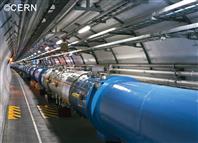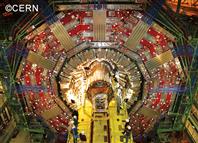Thirty-three years after his Alien started the cult of the thorax-bursting body snatchers, director Ridley Scott gave us a prequel to the saga in the form of Prometheus. The actions in the latter film have not only gone back in chronological time but also redirected the seemingly doomed space journey towards the origin of the human race.
Man’s quest for his origin is not fodder for the imagination of the artists only. In science a similar but more rigorous quest has been going on for quite some time, with less violent or ghastly manifestations. Physicists view the physical universe in terms of fields, forces, particles, energy and matter. The standard model of particle physics explains its working as a combination of the weak nuclear force, the strong force and electromagnetism.
All is so very well, but there is a missing piece to the jigsaw. Where does the mass of the fundamental particles come from? And why do different particles have different masses? A half century ago, the Scottish physicist Peter Higgs theorized that there is an energy field which gives mass to particles trawled through it.
Tracking God Particle
Prof. Chu Ming-chung, professor of physics at CUHK, likened the Higgs field to water. When we walk in water, we feel we are pulled back or weighed down, as if we have been given extra ‘mass’. That is a field suffused with mass or mass-giving particles. How can the existence of the field be proved? Imagine a blind man standing on the shore. By throwing a stone into the water, he can tell by the sound of the water breaking that it’s all water instead of rock in front of him. Similarly, scientists would smash high-energy particles so that the resulting explosion would disrupt the field and release Higgs particles which can be detected and whose traces can be analysed.
But this Higgs particle, which later came to be called the God particle, had proved elusive. Man proposed, but God was not ready to dispose. This is because the particle accelerators were not yet powerful enough to set loose the Higgs. But the arrival of the much more powerful Large Hadron Colliders (LHCs) in the later part of the 2000s changed all that.
The LHC at the European Center for Nuclear Research (CERN) in Geneva, 26.5 km in circumference and 90 m deep in the ground, can smash protons at 99.9999991% of the speed of light, thereby producing fireballs with effervescent particles such as the Higgs and leaving traces which can prove its existence. For some months since the beginning of this year, the scientific community had been holding its breath in anticipation of the tracking and proving of the existence of the God particle. Then in July, the research teams at CERN announced they have found a Higgs-like particle. The whole world erupted in euphoria. But a lot remains to be done.
Professor Chu explained, ‘The scientists at CERN would then have to measure the ratio of the different ways of decay of this Higgs-like particle, to see whether the particle is the same as the standard model Higgs. In fact, some of the ways this particle can decay have not been observed yet. So they need to have more events in order to see all the decay modes of the particle.’ Professor Chu estimated that by the end of the year they should have doubled the statistics and so the confidence level would be much higher.
Professor Chu continued, ‘If the Higgs particle is indeed found, there are still quite a bit of other new physics that they are looking for at CERN. The most immediate is to test the theory of supersymmetry, which predicts a new class of particles called supersymmetric partners. If they cannot find these particles within the next few years, then the theory of supersymmetry will be in serious trouble, and so will many grand unified theories based on it. If they find these supersymmetric partners, it will be important to characterize them (mass and other physical properties). They may be the so-called “dark matter” in the universe, and their properties have great significance in astrophysics and cosmology as well.’
In Quest of Neutrino
Professor Chu is also the leader of the Hong Kong part of an international team in the Daya Bay Reactor Neutrino Experiment, which comprises over 200 scientists from 39 institutes in China, the US, Taiwan, Russia and the Czech Republic. The Daya Bay Experiment will help to answer some of the most puzzling questions about neutrinos.
Professor Chu said, ‘Neutrinos are uncharged particles produced in nuclear reactions and are among the lightest elementary particles. The several forms of neutrino morph from one to another but hardly interact at all as they travel through space and matter. Like the Higgs, they are elusive and difficult to detect. In the standard model of particle physics, the neutrinos do not have mass. But now we know they do have a tiny mass, which they may have acquired through interacting with the Higgs particles. While the discovery of Higgs is a confirmation of the standard model, neutrino oscillation (what we study at Daya Bay) is beyond the standard model. So the neutrinos provide a promising window for us to study where the standard model trails off.’
Recently, CUHK has strengthened its collaboration with CERN with the signing of an agreement with the Compact Muon Solenoid Experiment (CMS) at CERN for CUHK scientists and students to take part in the research programme. CMS is one of the two major experiments at CERN and was designed to detect a wide range of particles and phenomena produced in high-energy collisions in the LHC. It therefore plays a part in detecting and confirming the existence of fundamental particles including the Higgs. CUHK students will continue to benefit from research experience gained in the yearly CERN Summer Student Programme.
One author remarks, ‘The boson found in the deep tunnel at CERN goes to the very essence of everything.’ (‘The Cathedral of Science’, Time, 23 July, 2012, p. 31) It is this very core of everything that inspires awe and faith in every one of us, scientist or layman. Like the survivor on the spaceship Prometheus in Ridley Scott’s film, man’s quest for the ultimate answer continues. 





































































































































































Social Bookmarks